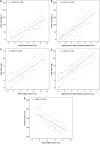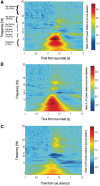Subthalamic nucleus activity optimizes maximal effort motor responses in Parkinson's disease
- PMID: 22858550
- PMCID: PMC3437023
- DOI: 10.1093/brain/aws183
Subthalamic nucleus activity optimizes maximal effort motor responses in Parkinson's disease
Abstract
The neural substrates that enable individuals to achieve their fastest and strongest motor responses have long been enigmatic. Importantly, characterization of such activities may inform novel therapeutic strategies for patients with hypokinetic disorders, such as Parkinson's disease. Here, we ask whether the basal ganglia may play an important role, not only in the attainment of maximal motor responses under standard conditions but also in the setting of the performance enhancements known to be engendered by delivery of intense stimuli. To this end, we recorded local field potentials from deep brain stimulation electrodes implanted bilaterally in the subthalamic nuclei of 10 patients with Parkinson's disease, as they executed their fastest and strongest handgrips in response to a visual cue, which was accompanied by a brief 96-dB auditory tone on random trials. We identified a striking correlation between both theta/alpha (5-12 Hz) and high-gamma/high-frequency (55-375 Hz) subthalamic nucleus activity and force measures, which explained close to 70% of interindividual variance in maximal motor responses to the visual cue alone, when patients were ON their usual dopaminergic medication. Loud auditory stimuli were found to enhance reaction time and peak rate of development of force still further, independent of whether patients were ON or OFF l-DOPA, and were associated with increases in subthalamic nucleus power over a broad gamma range. However, the contribution of this broad gamma activity to the performance enhancements observed was only modest (≤13%). The results implicate frequency-specific subthalamic nucleus activities as substantial factors in optimizing an individual's peak motor responses at maximal effort of will, but much less so in the performance increments engendered by intense auditory stimuli.
Figures







References
-
- Angel A. Input-output relations in simple reaction time experiments. J Exp Psychol. 1973;25:193–200. - PubMed
-
- Anzak A, Tan H, Pogosyan A, Djamshidian A, Ling H, Lees A, et al. Improvements in rate of development and magnitude of force with intense auditory stimuli in patients with Parkinson's disease. Eur J Neurosci. 2011a;34:124–32. - PubMed
-
- Anzak A, Tan H, Pogosyan A, Brown P. Doing better than your best: loud auditory stimulation yields improvements in maximal voluntary force. Exp Brain Res. 2011b;208:237–43. - PubMed
-
- Aravamuthan BR, McNab JA, Miller KL, Rushworth M, Jenkinson N, Stein JF, et al. Cortical and subcortical connections within the pedunculopontine nucleus of the primate Macaca mulatta determined using probabilistic diffusion tractography. J Clin Neurosci. 2009;16:413–20. - PubMed
-
- Ballanger B, Thobois B, Batusche P, Turner RS, Brouselle E, Desmurget M. “Paradoxical kinesis” is not a hallmark of Parkinson’s disease but a general property of the motor system. Mov Disord. 2006;21:1490–5. - PubMed
Publication types
MeSH terms
Grants and funding
LinkOut - more resources
Full Text Sources
Medical
Miscellaneous

